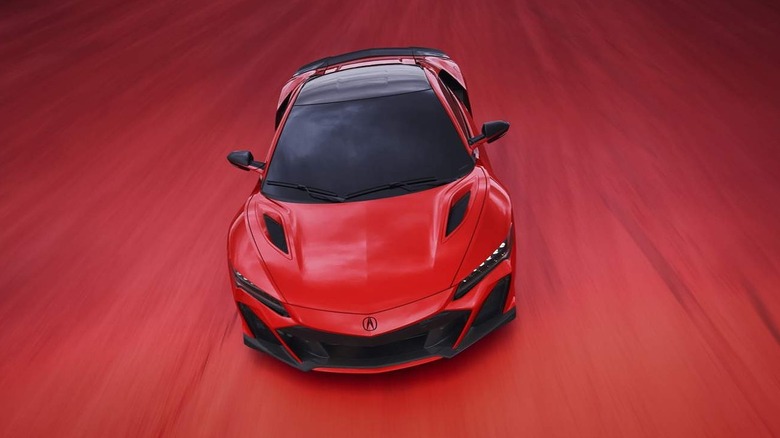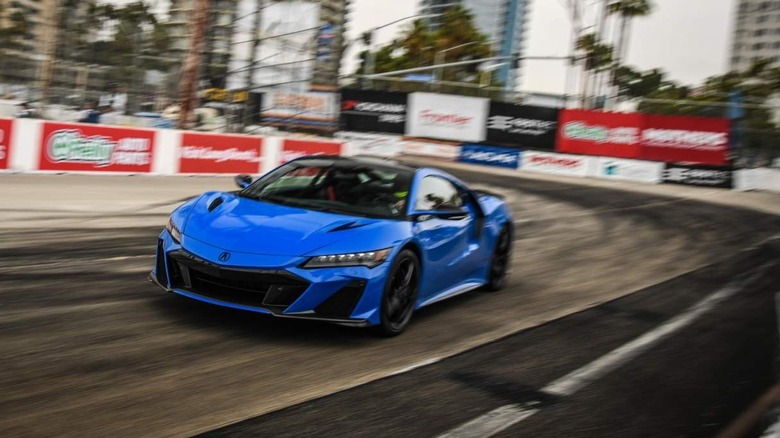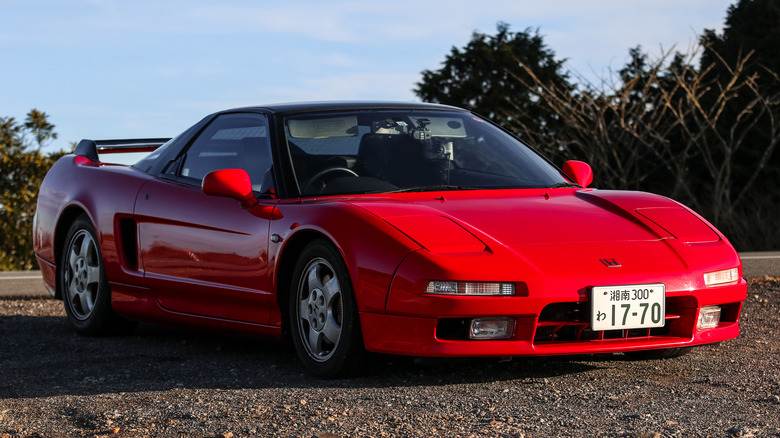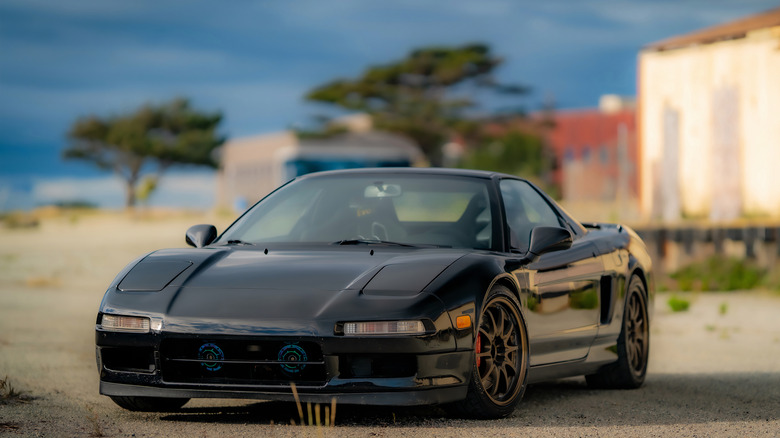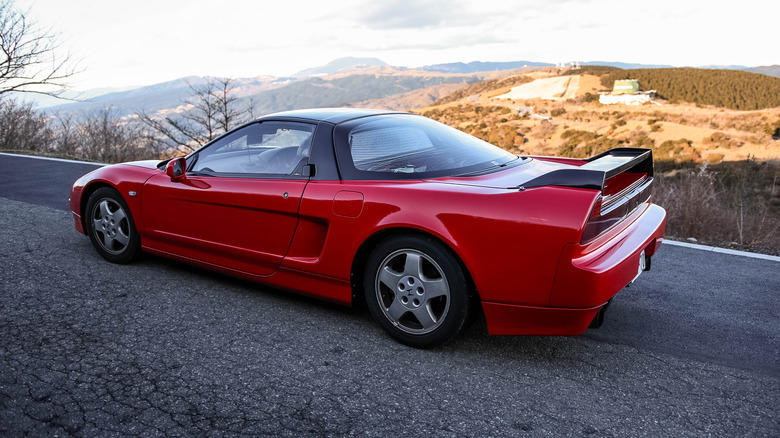What Made The Honda NSX Such A Unique Sports Car
The current second-gen Honda NSX (or Acura NSX) is commemorating its twilight year with a new Type S variant boasting more power and exclusivity than ever before. The NSX sports hybrid is bowing down after seven years of production, and only 300 NSX Type S models will arrive at American Acura dealerships in 2022.
The NSX never sold in huge numbers – we're talking about the second-gen hybrid NSX – not because it's a bad-looking car, and it has nothing to do with performance, either. The new NSX Type S broke the production car lap record at Long Beach by completing an entire lap in one minute and 32.8 seconds, more than two seconds quicker than the lap record set by a none-Type S NSX in 2019.
No, the NSX didn't resonate well with supercar buyers due to its sub-$200k base price. In a world where a Mercedes-AMG GT or an Aston Martin Vantage has more power and more exotic supercar styling at a similar price point, the Honda NSX has its work cut out for it, but it doesn't mean it's not as unique as its iconic first-gen brethren.
NSX Sports Hybrid: The everyday supercar
Timeline 1984: The bigwigs at Honda Japan were drumming up ideas of shifting from the automaker's conventional FF front-engine, front-wheel-drive format to a more interesting one. But with Honda being Honda, it wasn't ready to compromise interior room and everyday usability in the name of almighty performance. So, the engineers at Honda's Wako R&D center came up with an underfloor, midship-engine rear-wheel drive (UMR) architecture combining the best of both worlds. The same philosophy rings true in the second-generation NSX sports hybrid.
True, the NSX hybrid is not as straightforward or basic as the legendary first-gen model with its three electric motors and Super Handling All-Wheel Drive (SH-AWD). However, it still has 500 to 600 horsepower from its electrified twin-turbo V6 powertrain, and it's the sort of supercar you can live with every single day: It has a roomy interior, plenty of hi-tech connectivity options, modest boot space, and all-weather traction from its hybrid AWD system.
Plus, it's not as thirsty as a Ferrari or Lamborghini. As SlashGear's Chris Davies pointed out in his Acura NSX test drive in 2017, "the computer bashfully admitted it was still returning 19 mpg after bashing it all day," so you have your cake and eat it, too – if you can live with the NSX's price tag, of course.
What made the Honda NSX a unique sports car?
When it comes to uniqueness, you're probably referring to the illustrious first-gen NSX that debuted in 1990. Did you know that Honda tested its first rear-wheel-drive architecture using a first-generation Honda City? It later spawned a CR-X prototype in 1983, about the same time when Honda is celebrating its return to Formula One racing.
"It's the dream of every development engineer to create a sports car," said Shigeru Uehara, Executive Chief Engineer of the NSX project. "I think the company wanted a car that could bridge its mass production FF models and F1 cars," Uehara added. "They needed a car that would become the new face of Honda, and we'd been contacted several times by the Acura Division at American Honda concerning similar requests."
In 1984, Honda commissioned the famous Italian styling house Pininfarina to create the Honda HP-X, a concept that exemplifies the future of Honda/Acura's halo car. The goal is a production sports car that will shame most German or Italian performance cars at a lesser price without sacrificing daily usability and reliability. Hence, the HP-X gave way to the NS-X or "New Sportscar eXperimental," the genesis of the production NSX.
All-aluminum monocoque body
The Honda NSX is the world's first mass-production vehicle to have an all-aluminum monocoque body, making it unique back in the day. But then again, the aluminum body is only part of what made the NSX a potent sports car. According to Prof. Gordon Murray CBE, the NSX's aluminum suspension is one of the primary reasons why it is one of the best sports cars of all time.
The original NSX was so good that Prof. Murray confessed to "copying" the elements of what made it great (like the aluminum-intensive construction, drive-by-wire throttle, and air-conditioning system) to conceptualize the McLaren F1, the most incredible supercar ever built. If you're not aware, Prof. Murray is also behind the GMA T.50 and GMA T.33, two of the most hotly-anticipated sports cars of the modern era.
F1 perfection
For us, the Honda/Acura NSX is unique because it's the only production supercar signed off by the late, great Ayrton Senna, the most fantastic F1 driver of all time. Senna wasn't impressed with the NS-X prototype, calling it "fragile" after a test run around Suzuka. As per Senna's request, the engineers did their homework by fine-tuning the suspension and stiffening the chassis, resulting in the only production machine to earn the master's approval.
It helps that the NSX has a naturally-aspirated V6 engine with 270 horsepower and revs to a bewildering 8,200 rpm, helping it accelerate from zero to 60 mph in 5.7 seconds and a 170 mph top speed, effectively a fighter jet for the road, according to Car and Driver. But the fact that Senna sprinkled his magic into the NSX makes it truly one for the books.
